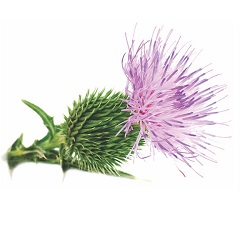
Medicine: MANOLIVER
Use: Not only used as a herbal tea, Milk thistle is also prescribed in cases of dyspepsia with hepatic origins.
Milk thistle (Silybum marianum) is a thorny plant presenting decorative leaves with a white pattern of veins and purple flower heads. Milk thistle (silymarin) is a flowering herb related to the daisy and ragweed family. It is native to Mediterranean countries. Some people also call it Mary thistle and holy thistle.
Milk thistles can grow to be 30 to 200 cm tall, and have an overall conical shape. The plant is sometimes also used as a decorative element in gardens, and its dried flower heads may be used for the decoration of dry bouquets.
Silymarin is the main active ingredient in milk thistle. Silymarin is both an anti-inflammatory and antioxidant.
Milk thistle is taken by mouth most often for liver disorders, including liver damage caused by chemicals, alcohol, and chemotherapy, as well as liver damage caused by Amanita mushroom poisoning, nonalcoholic fatty liver disease, chronic inflammatory liver disease, cirrhosis of the liver, and chronic hepatitis. Some people apply milk thistle directly to the skin for skin damage caused by radiation.
In foods, milk thistle leaves and flowers are eaten as a vegetable for salads and a substitute for spinach. The seeds are roasted for use as a coffee substitute.
Milk thistle seed might protect liver cells from toxic chemicals and drugs. It also seems to have blood sugar-lowering, antioxidant, and anti-inflammatory effects.